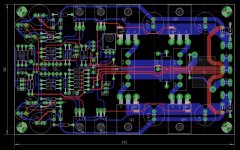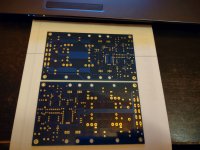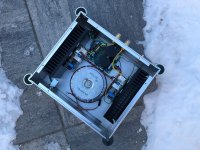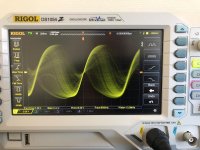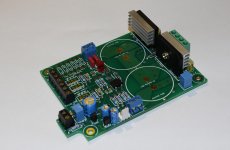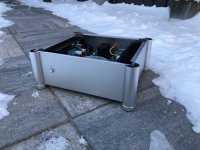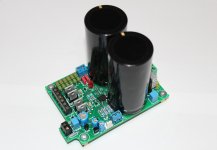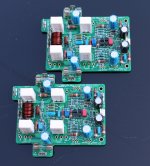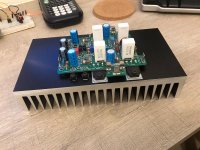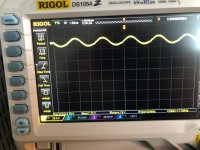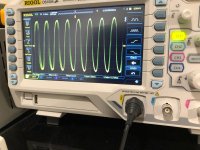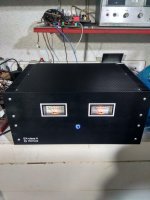Kaplaars struggles on
Too long no see! I have to confess that it has been a while since I made progress with the Ovation Amplifier. However, meanwhile I have acquired some parts, perfect heatsinks and finally putted everything in a cabinet. Far from finished yet, as I also want to put some nice VU-indicators and rearrange the wiring a bit better and more tidy, but the idea is more or less there.
In the end I decided to make a different configuration than I posted a while ago Today I decided to run some tests. Nice flat frequency response at a very broad spectrum, very low levels of noise, excellent square wave response with no ringing visible. It is a real power house and gives about 108W RMS @8ohms.
So I decided to put some music. There unfortunately things went less prosperous ;-). I use the computer as preamp. I mentioned that when connecting the RCA's to the amplifier, while being plugged into the computer soundcard, the amplifier started to draw quite some power (+1A @230V, long live the series lightbulb). Even worse the Zobel resistors became hot. Fortunately it is cold right now in NL, but our heating system is already sufficient. Now, I do remember SjoerdSmits experienced years ago more or less the same issue in a different context. Also his Zobel resistors got fried. So I guess it is definitely a Dutch thing 😀 This effect seemed to be a bit at random at first, but after fiddling around I saw a pattern; it happens only when having connected, or connecting the RCA to the amplifier. And only when the other side of the RCA was already plugged into the computer. I can induce this effect at both channels. I measured the outputs while an 8 ohm load was attached. Making a picture was quite tricky as continuing too long would fry the Zobel, but I managed. Now I compared the input and the output and to my surprise, it is actually the soundcard/computer that is injecting this signal of +/1 1MHz. Somehow it seems to be connected with the computer itself. I have two soundcards in this computer and both give the same effect. So fortunately, as it seems, it is not the amplifier itself that is oscillating. I can also not induce, or quit this effect when the outputs are shorted. The computer is not grounded, maybe that is already part of the problem. But this somehow worries me a bit as this can be quite tricky when you have an unstable pre. Bonsai and others, do you have suggestions how to tackle this? Is it maybe advisable to put a low pass filter as the amplifier amplifies a very broad spectrum (even at 1.8MHz there is still quite some gain)?
Further, I followed all rules with two exceptions; 1) rail voltages are a bit higher at 52VDC (old 35VAC transformer that is originally made for 220VAC), 2) I biased a bit less than advised and went for 200mA (the manual mentions 300mA if I recall correctly) to save some power consumption. Am I taking a gamble with the rail voltages being a bit too high?
Regards,
Michael
Too long no see! I have to confess that it has been a while since I made progress with the Ovation Amplifier. However, meanwhile I have acquired some parts, perfect heatsinks and finally putted everything in a cabinet. Far from finished yet, as I also want to put some nice VU-indicators and rearrange the wiring a bit better and more tidy, but the idea is more or less there.
In the end I decided to make a different configuration than I posted a while ago Today I decided to run some tests. Nice flat frequency response at a very broad spectrum, very low levels of noise, excellent square wave response with no ringing visible. It is a real power house and gives about 108W RMS @8ohms.
So I decided to put some music. There unfortunately things went less prosperous ;-). I use the computer as preamp. I mentioned that when connecting the RCA's to the amplifier, while being plugged into the computer soundcard, the amplifier started to draw quite some power (+1A @230V, long live the series lightbulb). Even worse the Zobel resistors became hot. Fortunately it is cold right now in NL, but our heating system is already sufficient. Now, I do remember SjoerdSmits experienced years ago more or less the same issue in a different context. Also his Zobel resistors got fried. So I guess it is definitely a Dutch thing 😀 This effect seemed to be a bit at random at first, but after fiddling around I saw a pattern; it happens only when having connected, or connecting the RCA to the amplifier. And only when the other side of the RCA was already plugged into the computer. I can induce this effect at both channels. I measured the outputs while an 8 ohm load was attached. Making a picture was quite tricky as continuing too long would fry the Zobel, but I managed. Now I compared the input and the output and to my surprise, it is actually the soundcard/computer that is injecting this signal of +/1 1MHz. Somehow it seems to be connected with the computer itself. I have two soundcards in this computer and both give the same effect. So fortunately, as it seems, it is not the amplifier itself that is oscillating. I can also not induce, or quit this effect when the outputs are shorted. The computer is not grounded, maybe that is already part of the problem. But this somehow worries me a bit as this can be quite tricky when you have an unstable pre. Bonsai and others, do you have suggestions how to tackle this? Is it maybe advisable to put a low pass filter as the amplifier amplifies a very broad spectrum (even at 1.8MHz there is still quite some gain)?
Further, I followed all rules with two exceptions; 1) rail voltages are a bit higher at 52VDC (old 35VAC transformer that is originally made for 220VAC), 2) I biased a bit less than advised and went for 200mA (the manual mentions 300mA if I recall correctly) to save some power consumption. Am I taking a gamble with the rail voltages being a bit too high?
Regards,
Michael
Attachments
Last edited:
Hello
I will have to come back to you a bit later today on this. What PSU are you using with your nx-Amp? Do you have the Zobel connected?
It seems you only have the problem when you plug the amp into a source?
I will have to come back to you a bit later today on this. What PSU are you using with your nx-Amp? Do you have the Zobel connected?
It seems you only have the problem when you plug the amp into a source?
Thanks Bonsai, sure there is no rush! Already super cool that you are willing to help.
1) The PSU I am using is Version 2.0, obtained from Jims Audio (attached a picture)
2) Yes, the Zobel is connected
3) True, only when plugged in into a source (when I short the inputs when plugged in, the problem is gone)
I was just checking with another amplifier that can amplify also quite a broad spectrum. But somehow I can not reproduce this phenomenon with this amplifier. I also grounded the PC. But that does not help.
1) The PSU I am using is Version 2.0, obtained from Jims Audio (attached a picture)
2) Yes, the Zobel is connected
3) True, only when plugged in into a source (when I short the inputs when plugged in, the problem is gone)
I was just checking with another amplifier that can amplify also quite a broad spectrum. But somehow I can not reproduce this phenomenon with this amplifier. I also grounded the PC. But that does not help.
Attachments
Can you send me a close up photo of one of the amp PCB’s please so I can see the components?
Some quick things to try
- if you connect a CD player or some other source, is everything ok? If yes, might be an interaction between the PC and the amp
- swap the live and neutral around in your amp (checking for common mode noise from the PC <> nx-Amp PSU
- how are the input connectors wired? The connector signal ground must not make contact with the chassis?
- are you using a Ground Lifter? If yes, consider shorting it out ie direct connection to the chassis
-Also, check that your signal and ground connections from your PC cable are not swapped
Some quick things to try
- if you connect a CD player or some other source, is everything ok? If yes, might be an interaction between the PC and the amp
- swap the live and neutral around in your amp (checking for common mode noise from the PC <> nx-Amp PSU
- how are the input connectors wired? The connector signal ground must not make contact with the chassis?
- are you using a Ground Lifter? If yes, consider shorting it out ie direct connection to the chassis
-Also, check that your signal and ground connections from your PC cable are not swapped
Last edited:
Nice chassis BTW - where did you get it?
The chassis look nice but not very practical with the screws from the inside.
@Kaplaars
do I see it correctly, you tied input twisted wires to output wires of the second amplifiers, try to put away input wires from strong signal.
do I see it correctly, you tied input twisted wires to output wires of the second amplifiers, try to put away input wires from strong signal.
Today was arrived by my self designed PCB`s for NX amp...this weekend the assembling will coming up...any comments? suggestions?
You just have to build it and try it!
@ Jaques: true, but I see that as an advantage. In general I like to cover screws as much as possible ;-) Although it is certainly true that it takes a certain way to get everything apart.
@ Bonsai:
1) I obtained the chassis from AE:
WA113 Aluminium behuizing Voorversterker chassis eindversterker case/doos maat 280*320*120mm|Versterker| - AliExpress
The heatsinks are from Fisher. I cutted them such that they fitted. Attached some extra pictures. Ps. in the pictures you can still see a green jumper. I removed that one later. I hope that was indeed correct.
Q: if you connect a CD player or some other source, is everything ok? If yes, might be an interaction between the PC and the amp
A: Thus far I could not reproduce the issue with another source.
Q: swap the live and neutral around in your amp (checking for common mode noise from the PC <> nx-Amp PSU
A: That unfortunately has not helped.
Q: how are the input connectors wired? The connector signal ground must not make contact with the chassis?
A: True, they are isolated from the chassis.
Q: are you using a Ground Lifter? If yes, consider shorting it out ie direct connection to the chassis
A: Ground is not attached at this moment. I know, a bit livin' on the edge, but that will be attached after I fixed this problem.
Q: Also, check that your signal and ground connections from your PC cable are not swapped
A: The connections are OK and not swapped.
I also found something strange. The RCA sockets are somehow fiddly/do not make a true nice connection. When I fiddle a bit with them I can induce HF output when connected to the PC. Strangely now at a lower frequency (220KHz) and more like a sine wave (although a bad one). I would think that this could not induce oscillation at a frequency that high, ground issues at 50 or 100Hz would make more sense 🙂 What frightens me a bit is that the oscillation results into almost a full power signal (nice glowing lightbulb). I think the issue is a bit similar to what Sjoerd earlier described. Could there be a good way to protect the amplifier for induced HF signals while still keeping its sonic capabilities?
@ Bonsai:
1) I obtained the chassis from AE:
WA113 Aluminium behuizing Voorversterker chassis eindversterker case/doos maat 280*320*120mm|Versterker| - AliExpress
The heatsinks are from Fisher. I cutted them such that they fitted. Attached some extra pictures. Ps. in the pictures you can still see a green jumper. I removed that one later. I hope that was indeed correct.
Q: if you connect a CD player or some other source, is everything ok? If yes, might be an interaction between the PC and the amp
A: Thus far I could not reproduce the issue with another source.
Q: swap the live and neutral around in your amp (checking for common mode noise from the PC <> nx-Amp PSU
A: That unfortunately has not helped.
Q: how are the input connectors wired? The connector signal ground must not make contact with the chassis?
A: True, they are isolated from the chassis.
Q: are you using a Ground Lifter? If yes, consider shorting it out ie direct connection to the chassis
A: Ground is not attached at this moment. I know, a bit livin' on the edge, but that will be attached after I fixed this problem.
Q: Also, check that your signal and ground connections from your PC cable are not swapped
A: The connections are OK and not swapped.
I also found something strange. The RCA sockets are somehow fiddly/do not make a true nice connection. When I fiddle a bit with them I can induce HF output when connected to the PC. Strangely now at a lower frequency (220KHz) and more like a sine wave (although a bad one). I would think that this could not induce oscillation at a frequency that high, ground issues at 50 or 100Hz would make more sense 🙂 What frightens me a bit is that the oscillation results into almost a full power signal (nice glowing lightbulb). I think the issue is a bit similar to what Sjoerd earlier described. Could there be a good way to protect the amplifier for induced HF signals while still keeping its sonic capabilities?
Attachments
Last edited:
I can not edit the previous post, but I have a small update. As I did not have connected signal ground via an independent wire to the main ground I think I should have added a jumper at J2 (is that correct Bonsai?). That has been done (just like in the picture before). Unfortunately is has not solved the issue.
I found out how to reproduce the issue the easiest way. It only happens when I connect one RCA completely (so signal and GND), while I connect the other RCA only by signal (so not GND for one channel). And only when connected to the PC. What then happens is that I get a sine wave at about ~424 KHz at the input and at the output of the amplifier (of course not the same amplitude). This signal is induced from the PC. The strange thing however is that I can not induce this phenomenon when connecting another amplifier to the same PC and soundcard. Also I have no clue why it is now 424KHz and not 1MHz as shown earlier. Something is wrong, but what exactly is a mystery.
I found out how to reproduce the issue the easiest way. It only happens when I connect one RCA completely (so signal and GND), while I connect the other RCA only by signal (so not GND for one channel). And only when connected to the PC. What then happens is that I get a sine wave at about ~424 KHz at the input and at the output of the amplifier (of course not the same amplitude). This signal is induced from the PC. The strange thing however is that I can not induce this phenomenon when connecting another amplifier to the same PC and soundcard. Also I have no clue why it is now 424KHz and not 1MHz as shown earlier. Something is wrong, but what exactly is a mystery.
Attachments
From my experience, pc is a source of troubles for amplifiers.
I have many problems using laptop. Especially with an earthed smps!
I have many problems using laptop. Especially with an earthed smps!
Me, I don't understand your architecture.Also I have no clue why it is now 424KHz and not 1MHz as shown earlier. Something is wrong, but what exactly is a mystery.
Me too I use a PC as "music streamer" and "music server" but, after it, galvanically insulated, there is a DAC, connected via USB (the +5V and it ground are not used). I don't use the volume control provided by the OS: if you are on Windows you are using the "Windows Mixer". Well known as "music killer". Me, I use the 32-bits digital control provided by the DAC (that I use also as digital preamplifier, for other sources: SkyQ on optical).
You should have a look on the Archimago findings about the noise that comes out from a PC. What happens to you seems such an extreme phenomenon.
What happens with the Ovation-nx if you use a DAC?
Thanks for thinking along! I agree with both of you teodorom and thimios. However, although the setup is not ideal, a heating Zobel resistor is most of the times indicative of oscillation. I have troubles to find what is causing this positive feedback. I disconnected the Zobel resistors to be able to test better and a bit longer. The oscillation frequency is not stable. But what is more; when I touch the inputs via a screw driver, the same effect happens. Being an antenna for 50Hz, I now understand what happened with the PC; earth was not always connecting right, so that gave hum, which caused somehow RF oscillation. So I blamed the PC falsely, it was actually hum that has been causing this problem. Now, the funny thing is that the same signal onto the output can also be seen onto the input. As if there is somehow indeed positive feedback. Also, how could it be that the 50Hz is transformed to a much higher frequency. Sure, I do like radio's, but this time I was not planning to build an oscillator 😀
I am curious if somebody is seeing something I do not see. Thanks for the help thusfar, super cool!
I am curious if somebody is seeing something I do not see. Thanks for the help thusfar, super cool!
Attachments
Try to add 1000pf-2200pf inside amplifier, directly connected from RCA gng to chassis. Keep lengs as short as possible.
With your PC plugged into the nx-Amp, what happens when you turn the PC off, with everything still connected?
Kaplaars, can you unplug your computer from the amp, and then with your scope measure the noise between the computer earth and each output on the computer - both the signal ground and the signal return.
Thanks thimios and Bonsai!
@thimios, good suggestion! I was thinking the same and I tried directly at the RCA inputs. Unfortunately it has not solved the issue. I was checking the schematic. There is a 220pF cap for more or less the same function on the boards themself. It has been fitted correctly.
@Bonsai: I isolated the problem to the amplifier itself. I can induce the same phenomenon by just gently touching the inputs while having a dummy load connected. Basically I inject 50Hz by acting as an antenna. However, at the output I see a sine wave, with no visible harmonics, of more than 200KHz (frequency varies depending on how hard you touch / changing resistance). It happens only when the dummy load is attached (so the amp can dump its energy). It happens with both channels independently. I removed the signal cables to make sure I was not picking up noise (the cables are twisted, but not shielded yet, I will replace that later). However, even with no signal cables attached, and just touching the input on the PCB itself / inducing hum, immediately causes the same effect. It would be logical if the amplified hum signal is 50Hz, but it is somehow transformed. That transformed hum signal causes the Zobel to heat up. The strange thing is, when I apply a sine wave with a signal generator, there is a perfect sinewave at the output of the right frequency. And that till +2MHz. My scope has a limited FFT function, but no harmonics can be detected. Also I do not see any ringing when applying a square wave of 1KHz.
Summary of what I know thus far:
The problem arises when hum is induced by; connecting an improper/not well shielded cable, or by touching the input. This results in more or less a (crippled) sine wave at the output ranging between 400KHz and 490KHz (I can chance this frequency a bit by fiddling with pressure) at almost full power. When the Zobel is connected it gets fried (so I now disconnected it) when changing inputs / inducing hum.
The amplifier runs on on a rail voltage of 52VDC | 0 | 52VCD (lowering the voltage via an variac does not have an effect onto the problem). Connecting, or disconnecting J2 does not make any difference. I am still not sure weater I should connect or disconnect it (manual says remove so the hum breaking resistors work, but in this topic I read to keep it).
Parts are all original, from reputable companies (Digikey, Mouser, Conrad).
Bias setting does not affect the issue, amplifier is biased at 200mA (100mA per output device), there are no problems with changing bias or nulling the output to zero. Heatsinks keep cool. Of course only heating up when delivering power, but acceptable (max 40 degrees).
When nothing is connected to the amplifier, there is no audible hum, oscillation etc. Of course, there is a tiny bit of noise at the output, but very small and not very different from other amplifiers.
I took care with routing (of course it can always be improved), earth is not connected (yet), connecting GND of the amplifier to the chassis or not does not affect the problem. Although connecting GND does lower noise a bit (to be expected).
The problem is independent from both channels, and occurs at both channels with more or less the same intensity.
A nice but difficult puzzle to solve ;-). I guess somehow I made a mistake with populating the boards. Could you see an error on the pictures I sended? Do you know of others that also experienced this problem Bonsai? I used the search function, the only member that seem to have experienced something similar is Sjoerd. And I think Andrew had some oscillation problems. I am not sure if and or they tackled their problems / found the cause. Do you have other suggestions?
@thimios, good suggestion! I was thinking the same and I tried directly at the RCA inputs. Unfortunately it has not solved the issue. I was checking the schematic. There is a 220pF cap for more or less the same function on the boards themself. It has been fitted correctly.
@Bonsai: I isolated the problem to the amplifier itself. I can induce the same phenomenon by just gently touching the inputs while having a dummy load connected. Basically I inject 50Hz by acting as an antenna. However, at the output I see a sine wave, with no visible harmonics, of more than 200KHz (frequency varies depending on how hard you touch / changing resistance). It happens only when the dummy load is attached (so the amp can dump its energy). It happens with both channels independently. I removed the signal cables to make sure I was not picking up noise (the cables are twisted, but not shielded yet, I will replace that later). However, even with no signal cables attached, and just touching the input on the PCB itself / inducing hum, immediately causes the same effect. It would be logical if the amplified hum signal is 50Hz, but it is somehow transformed. That transformed hum signal causes the Zobel to heat up. The strange thing is, when I apply a sine wave with a signal generator, there is a perfect sinewave at the output of the right frequency. And that till +2MHz. My scope has a limited FFT function, but no harmonics can be detected. Also I do not see any ringing when applying a square wave of 1KHz.
Summary of what I know thus far:
The problem arises when hum is induced by; connecting an improper/not well shielded cable, or by touching the input. This results in more or less a (crippled) sine wave at the output ranging between 400KHz and 490KHz (I can chance this frequency a bit by fiddling with pressure) at almost full power. When the Zobel is connected it gets fried (so I now disconnected it) when changing inputs / inducing hum.
The amplifier runs on on a rail voltage of 52VDC | 0 | 52VCD (lowering the voltage via an variac does not have an effect onto the problem). Connecting, or disconnecting J2 does not make any difference. I am still not sure weater I should connect or disconnect it (manual says remove so the hum breaking resistors work, but in this topic I read to keep it).
Parts are all original, from reputable companies (Digikey, Mouser, Conrad).
Bias setting does not affect the issue, amplifier is biased at 200mA (100mA per output device), there are no problems with changing bias or nulling the output to zero. Heatsinks keep cool. Of course only heating up when delivering power, but acceptable (max 40 degrees).
When nothing is connected to the amplifier, there is no audible hum, oscillation etc. Of course, there is a tiny bit of noise at the output, but very small and not very different from other amplifiers.
I took care with routing (of course it can always be improved), earth is not connected (yet), connecting GND of the amplifier to the chassis or not does not affect the problem. Although connecting GND does lower noise a bit (to be expected).
The problem is independent from both channels, and occurs at both channels with more or less the same intensity.
A nice but difficult puzzle to solve ;-). I guess somehow I made a mistake with populating the boards. Could you see an error on the pictures I sended? Do you know of others that also experienced this problem Bonsai? I used the search function, the only member that seem to have experienced something similar is Sjoerd. And I think Andrew had some oscillation problems. I am not sure if and or they tackled their problems / found the cause. Do you have other suggestions?
Last edited:
- Home
- Amplifiers
- Solid State
- SX-Amp and NX-Amp
